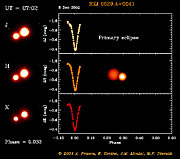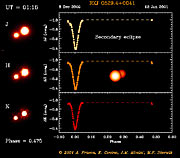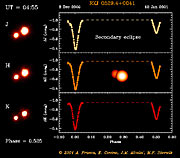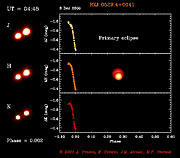Communiqué de presse
Young and Waltzing Binary Stars
ADONIS Observes Low-mass Eclipsing System in Orion
8 octobre 2001
A series of very detailed images of a binary system of two young stars have been combined into a movie. In merely 3 days, the stars swing around each other. As seen from the earth, they pass in front of each other twice during a full revolution, producing eclipses during which their combined brightness diminishes. A careful analysis of the orbital motions has now made it possible to deduce the masses of the two dancing stars. Both turn out to be about as heavy as our Sun. But while the Sun is about 4500 million years old, these two stars are still in their infancy.
They are located some 1500 light-years away in the Orion star-forming region and they probably formed just 10 million years ago. This is the first time such an accurate determination of the stellar masses could be achieved for a young binary system of low-mass stars. The new result provides an important piece of information for our current understanding of how young stars evolve.
The observations were obtained by a team of astronomers from Italy and ESO [1] using the ADaptive Optics Near Infrared System (ADONIS) on the 3.6-metre telescope at the ESO La Silla Observatory.
Binary stars and stellar masses
Since some time, astronomers have noted that most stars seem to form in binary or multiple systems. This is quite fortunate, as the study of binary stars is the only way in which it is possible to measure directly one of the most fundamental quantities of a star, its mass.
The mass of a star determines its fate . Massive stars (with masses more than 50 times that of the Sun) lead a glorious, but short life. They are hot and very luminous and exhaust their energy supply in just a few million years. At the other end of the scale, low-mass stars like the Sun are more economical with their resources. Being cooler and dimmer, they are able to shine for billions of years [2].
But although the mass determines the fate of a star, it is not a trivial matter to measure this crucial parameter. In fact, it can only be determined directly if the star happens to be gravitationally bound to another star in a binary stellar system. Observations of the orbital motions of the two stars as they circle each other allows to "weigh" them, and also provide other important information, e.g. about their sizes and temperatures.
Orbital motions
The understanding of orbital motions has a long history in astronomy. The basic laws of Johannes Kepler (1571-1630) are still used to calculate the masses of orbiting objects, in the solar system as well as in binary stellar systems. However, while the observations of the motion of the nine planets and moons have allowed us to measure quite accurately the masses of objects in our vicinity, the information needed to "weigh" the binary stellar systems is not that easy to obtain. As a result, the mass estimates of the stars in binary systems are often rather uncertain.
A main problem is that the individual stars in many binary systems can not be visually separated, even in the best telescopes. The information about the orbit may then come from the motions of the stars, if these are revealed by spectroscopic observations of the combined light (such systems are referred to as "spectroscopic binaries").
If absorption lines from both components are present in the spectrum, the measured wavelength of these double lines will shift periodically back and forth. This is the well-known Doppler effect and it directly reflects the changing velocities of the stars, as they move along their orbits and periodically approach and recede from the observer. Such spectroscopic observations therefore allow to measure the orbital velocities of the stars. It is exactly the same technique that is used to study and weigh extra-solar planets orbiting other stars [3].
However, this method has an important limitation. From the spectroscopical observations alone, it is only possible to deduce limits on the masses, as the inclination of orbits to the line-of-sight is usually unknown. The masses derived in this way (for stars as well as for exoplanets) are therefore only lower limits on the actual masses.
Eclipsing Binaries
However, fortunate observational circumstances sometimes allow to obtain all information about the stellar orbits. If a binary system is viewed (almost exactly) edge-on, the stars may pass in front of each other from time to time. Astronomers refer to this phenomenon as an "eclipse" and speak about an "eclipsing binary".
The effect is similar to a "solar" eclipse as seen on the Earth, whenever the Moon passes in front of the Sun. Like the Moon blocks the sunlight, less light is received from the eclipsed star and thus the combined light from the binary system decreases during the eclipse. The way this happens (astronomers speak about the system's "lightcurve") then provides the additional information about the inclination of the orbit that is needed to determine exactly the stellar masses in a "spectroscopic" binary system. Very accurate values for the stellar diameters and the surface temperatures of the two stars can also be deduced. In short, when a full set of observations is available, it is possible to give a comprehensive description of an eclipsing binary system and its components.
Eclipsing, spectroscopic binaries thus represent true cornerstones for the determination of stellar masses, and as such they are fundamental for our understanding of stellar evolution. Rather few such systems are known, but they can also be used to check ("calibrate") other, indirect methods to derive stellar parameters.
It is on this background that the first discovery of an eclipsing binary system with two young, solar-like stars is of great interest.
The Orion Binary
Young stars are not so easy to find. One way is to look for their high-energy emission from a hot corona, created by their enhanced magnetic activity. The object RXJ 0529.4+0041 was first discovered in this way by the X-ray satellite ROSAT.
Subsequent optical spectroscopy showed this object to be a young, low-mass spectroscopic binary system. And when a team of astronomers [1] used a 91-cm telescope at the Serra La Nave observing station on the slope of the Etna volcano (Sicily) to monitor the light curve, they also discovered that this system undergoes eclipses.
All data confirm that RXJ 0529.4+0041 is located in the Orion Nebula at a distance of about 1500 light-years. This is one of the nearest star-forming regions and almost all stars in this area are quite young. Spectroscopic observations soon confirmed that the binary system was no exception. In particular, fairly strong absorption lines of the fragile element Lithium [4] were detected in both of the binary stars. As Lithium is known to be rapidly destroyed in stars, the finding of a relatively high content of this element implies that the stars must indeed be young. They were probably formed no more than 10 million years ago, i.e., in astronomical terms, they are "infant" stars.
High-resolution spectroscopic observations, mostly with the CORALIE spectrometer on the Swiss 1.2-m Leonard Euler telescope at the ESO La Silla Observatory, were used to determine the radial velocities of the stars. From these, a first determination of the orbital and stellar parameters was possible.
The orbital period turned out to be short. The two stars swing around each other in just 3 days. This also means they must be very close to each other (but still entirely detached from each other) - the detailed analysis showed that the distance between the two components is only 12 solar radii, or a little more than 8 million kilometres. If you would image yourself standing on the surface of the smaller star, the disk of the companion star would extend some 15° in the sky. This is 30 times larger than our view of the Sun!
ADONIS observations
The short orbital period and the even shorter duration of the eclipses, only 6 hours, posed a real challenge for the observers. They decided to obtain further high-angular resolution observations with the ADaptive Optics Near Infrared System (ADONIS) on the 3.6-m telescope at the ESO La Silla Observatory. Most fortunately, early ADONIS images demonstrated that this binary stellar system has a third companion, sufficiently far away from the two others to be seen as a separate star by ADONIS. This unexpected bonus made it possible to monitor the light changes of the binary system in great detail, by using the third companion as a convenient "reference" star.
In December 2000 and January 2001, detailed ADONIS images of the RXJ 0529.4+0041 system were obtained in three near-infrared filters (the J-, H- and K-bands). ADONIS is equipped with the SHARP II camera and eliminates the adverse image-smearing effects of the atmospheric turbulence in real-time by means of a computer-controlled flexible mirror. As expected, the new, extremely sharp images of RXJ 0529.4+0041 greatly improved the achievable photometric precision. In particular, as the image of the third component was perfectly separated from the others, it did not "contaminate" the derived light curve of the eclipsing binary.
The movie
The ADONIS images have been combined into an instructive movie (ESO Press Video eso0133). The left-hand panel shows the eclipsing binary system (it is the upper right and brighter of the two objects; the light from the two stars merge into a single point of light) and the well visible third component (lower left), as they were recorded by ADONIS in the three different filter bands. As the two stars in the binary system move around each other in their orbits, eclipses occur and the brightness of the binary system clearly changes - it may help to play the movie several times to see this more clearly. For reference, the Universal Time (UT) and the orbital phase (increasing from 0 to 1 during a full revolution) are continuously displayed in the movie.
The right-hand panel shows a build-up of the observed light curves for the binary system. It represents the brightness difference between binary system and the third object that shines with constant light. Both the primary, deeper and the secondary, less deep eclipses are well visible. The primary eclipse was observed on December 8, 2000 and is here displayed at phase zero. During this minimum, the brightness of the binary system decreases by about 45% (0.4 magnitudes). The primary eclipse takes place when the smaller component blocks the light from the brighter and hotter star. The orbital motions of the two stars are illustrated by a computer-generated, animated sequence.
The secondary eclipse (at phase 0.5) dims the light from the system less; it occurs when the larger and brighter star almost completely (about 90%) hides its smaller companion. The second minimum was recorded on January 12, 2001. None of the eclipses is therefore "total".
The stellar parameters
A detailed analysis of these high-precision light curves allowed the astronomers to determine the orbits and hence, to perform an extremely accurate measurement of the fundamental stellar parameters for the two young stars of RXJ 0529.4+0041 .
The star that is eclipsed during the primary eclipse (the "primary") is the more massive and also the hotter and brighter of the two stars. Its mass is 1.3 times that of our Sun, i.e., about 2.6 10 30 kg [2]. Its diameter is nearly 1.6 times larger than that of our Sun (i.e., about 2.2 million km) and the surface temperature is found to be a little more than 5000 °C, or a few hundred degrees cooler than the Sun. The "secondary" star is slightly lighter than our Sun. Its weight is about 90% of that of the Sun (1.8 10 30 kg) and the diameter is 20% larger (about 1.7 million km), while the surface temperature is 4000 degrees.
In fact, these two stars are still so young that most of their energy comes from the contraction process - the first phase during which they are formed from an interstellar cloud by this process is not yet over and they are still getting smaller. It is by this process that collapsing stars heat up enough to start nuclear burning. When infant stars in RXJ 0529.4+0041 eventually reach middle-age, their sizes will most likely also be quite similar to that of the Sun.
The significance of RXJ 0529.4+0041
Few systems are known for which such precise determinations of the stellar parameters have ever been possible - and this binary system represents the first case where both the components are such young stars.
A detailed comparison of the derived stellar parameters with current models for the evolution of young stars shows fairly good agreement for the primary component. However, there are certain discrepancies in the case of the secondary component, showing that the current models for the early stages of lower-mass stars must still be refined.
Notes
[1] The team consists of Elvira Covino (Principal Investigator), Juan M. Alcalá, Rosita Paladino (all Osservatorio Astronomico di Capodimonte, Napoli, Italy), Antonio Frasca , Santo Catalano, Ettore Marilli (all Osservatorio Astrofisico di Catania, Italy) and Michael Sterzik (ESO-Chile).
[2] One solar mass corresponds to 1.99 10 30 kg, or about 330,000 times the mass of the Earth. The Sun is about 4500 million years old and its total lifetime is of the order of 12-13,000 million years. It is an interesting thought that if the Sun would have been somewhat heavier, its total lifetime might have been too short for living organisms to develop on the Earth. In fact, the biological evolution that ultimately lead to the emergence of human beings apparently lasted about 4 billion years; this corresponds to the total lifetime of a star that is only about 20 % heavier than the Sun. Note also the current ESO-ESA CERN educational programme on "Life in the Universe".
[3] In the case of exoplanets, the planet itself is not visible, but the spectral lines from the star are seen to wobble due to the gravitational influence of the planet.
[4] Several ESO Press Releases concern observations of the element Lithium in stars, e.g., eso9903 (in a giant star), eso0008 (in a metal-poor star) and eso0110 (from a "swallowed" exoplanet).
Plus d'informations
Part of the results described in this press release are described in more detail in a scientific article ("RXJ 0529.4+0041: a low-mass pre-main sequence eclipsing-spectroscopic binary" by E. Covino et al.) that has been published in the European research journal Astronomy & Astrophysics (Vol. 361, p. 49).
Contacts
Elvira Covino
Osservatorio Astronomico di Capodimonte
Napoli, Italy
Tél: +39 081 5575581
Courriel: covino@na.astro.it
Juan M. Alcalá
Osservatorio Astronomico di Capodimonte
Napoli, Italy
Tél: +39 081 5575479
Courriel: alcala@na.astro.it
Antonio Frasca
Osservatorio Astrofisico di Catania
Catania, Italy
Tél: + 39 095 7332240
Courriel: afr@ct.astro.it
Michael Sterzik
ESO
Santiago, Chile
Tél: +56 2 228 5006
Courriel: msterzik@eso.org
A propos du communiqué de presse
| Communiqué de presse N°: | eso0133 |
| Legacy ID: | PR 22/01 |
| Nom: | Adaptive Optics, Orion Nebula, RXJ 0529.4+0041 |
| Type: | Milky Way : Star : Grouping : Binary |
| Facility: | ESO 3.6-metre telescope |
| Instruments: | ADONIS |
| Science data: | 2000A&A...361L..49C |
Our use of Cookies
We use cookies that are essential for accessing our websites and using our services. We also use cookies to analyse, measure and improve our websites’ performance, to enable content sharing via social media and to display media content hosted on third-party platforms.
ESO Cookies Policy
The European Organisation for Astronomical Research in the Southern Hemisphere (ESO) is the pre-eminent intergovernmental science and technology organisation in astronomy. It carries out an ambitious programme focused on the design, construction and operation of powerful ground-based observing facilities for astronomy.
This Cookies Policy is intended to provide clarity by outlining the cookies used on the ESO public websites, their functions, the options you have for controlling them, and the ways you can contact us for additional details.
What are cookies?
Cookies are small pieces of data stored on your device by websites you visit. They serve various purposes, such as remembering login credentials and preferences and enhance your browsing experience.
Categories of cookies we use
Essential cookies (always active): These cookies are strictly necessary for the proper functioning of our website. Without these cookies, the website cannot operate correctly, and certain services, such as logging in or accessing secure areas, may not be available; because they are essential for the website’s operation, they cannot be disabled.
Functional Cookies: These cookies enhance your browsing experience by enabling additional features and personalization, such as remembering your preferences and settings. While not strictly necessary for the website to function, they improve usability and convenience; these cookies are only placed if you provide your consent.
Analytics cookies: These cookies collect information about how visitors interact with our website, such as which pages are visited most often and how users navigate the site. This data helps us improve website performance, optimize content, and enhance the user experience; these cookies are only placed if you provide your consent. We use the following analytics cookies.
Matomo Cookies:
This website uses Matomo (formerly Piwik), an open source software which enables the statistical analysis of website visits. Matomo uses cookies (text files) which are saved on your computer and which allow us to analyze how you use our website. The website user information generated by the cookies will only be saved on the servers of our IT Department. We use this information to analyze www.eso.org visits and to prepare reports on website activities. These data will not be disclosed to third parties.
On behalf of ESO, Matomo will use this information for the purpose of evaluating your use of the website, compiling reports on website activity and providing other services relating to website activity and internet usage.
Matomo cookies settings:
Additional Third-party cookies on ESO websites: some of our pages display content from external providers, e.g. YouTube.
Such third-party services are outside of ESO control and may, at any time, change their terms of service, use of cookies, etc.
YouTube: Some videos on the ESO website are embedded from ESO’s official YouTube channel. We have enabled YouTube’s privacy-enhanced mode, meaning that no cookies are set unless the user actively clicks on the video to play it. Additionally, in this mode, YouTube does not store any personally identifiable cookie data for embedded video playbacks. For more details, please refer to YouTube’s embedding videos information page.
Cookies can also be classified based on the following elements.
Regarding the domain, there are:
- First-party cookies, set by the website you are currently visiting. They are stored by the same domain that you are browsing and are used to enhance your experience on that site;
- Third-party cookies, set by a domain other than the one you are currently visiting.
As for their duration, cookies can be:
- Browser-session cookies, which are deleted when the user closes the browser;
- Stored cookies, which stay on the user's device for a predetermined period of time.
How to manage cookies
Cookie settings: You can modify your cookie choices for the ESO webpages at any time by clicking on the link Cookie settings at the bottom of any page.
In your browser: If you wish to delete cookies or instruct your browser to delete or block cookies by default, please visit the help pages of your browser:
Please be aware that if you delete or decline cookies, certain functionalities of our website may be not be available and your browsing experience may be affected.
You can set most browsers to prevent any cookies being placed on your device, but you may then have to manually adjust some preferences every time you visit a site/page. And some services and functionalities may not work properly at all (e.g. profile logging-in, shop check out).
Updates to the ESO Cookies Policy
The ESO Cookies Policy may be subject to future updates, which will be made available on this page.
Additional information
For any queries related to cookies, please contact: pdprATesoDOTorg.
As ESO public webpages are managed by our Department of Communication, your questions will be dealt with the support of the said Department.







